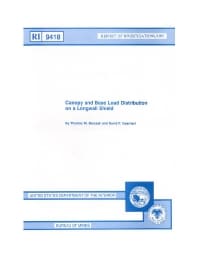Mining Publication: Canopy and Base Load Distribution on a Longwall Shield
Original creation date: January 1992
Authors: TM Barczak, DF Gearhart
NIOSHTIC2 Number: 10011245
Pittsbrugh, PA: U.S. Department of the Interior, Bureau of Mines, RI 9418, 1992 Jan; :1-23
This U.S. Bureau of Mines report examines the roof and floor contact pressure provided by the interaction of a shield with the surrounding strata. Controlled forces were applied to an 800-ton two-leg shield in the Bureau's mine roof simulator; the distribution of forces acting on the canopy and base of the shield were measured with 24 hydraulic pressure cells. Several influential factors that affect the load distribution were investigated: (1) the magnitude of loading (leg pressure); (2) the profile of the canopy, principally the upward-sloping tip; (3) the base-lifting device; (4) horizontal load acting on the shield; and (5) compliancy of the immediate roof and floor. It was concluded that the shield does not develop full canopy or base contact without deformation of the strata. Maximum contact pressures are developed at the rear of the canopy and on the toes of the base. Less than 10 pct of the available shield capacity is developed at the canopy tip despite the design intention to ensure tip contact. Horizontal loading reduced the toe pressure acting on the base by as much as 75 pct. The base-lifting device exaggerated the inherently high toe loading, increasing the contact pressure by more than 200 pct.

NIOSHTIC2 Number: 10011245
Pittsbrugh, PA: U.S. Department of the Interior, Bureau of Mines, RI 9418, 1992 Jan; :1-23
- Differential Pressure as a Measure of Particulate Matter Emissions from Diesel Engines
- Evaluation of Support and Ground Response as Longwall Face Advances into and Widens Pre-Driven Recovery Room
- Laboratory Testing To Quantify Dust Entrainment During Shield Advance
- Long-Term Stability of a Backfilled Room-and-Pillar Test section at the Buick Mine, Missouri, USA
- Longwall Shield and Standing Gateroad Support Designs - Is Bigger Better?
- Longwall Shield Recovery Using Mobile Roof Supports
- Make it Safer with Roof Screen
- The NIOSH Shield Hydraulics Inspection and Evaluation of Leg Data (Shield) Computer Program
- Sorption Investigations of Methane on Coal
- Technology News 490 - An Inexpensive Device for Monitoring Explosions in Sealed Areas of Underground Mines